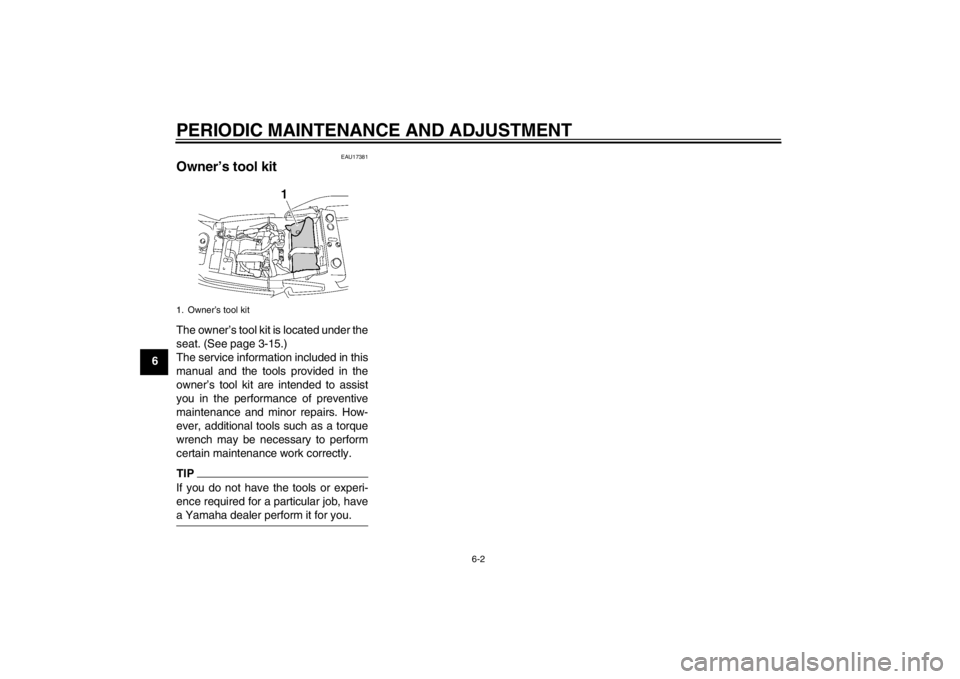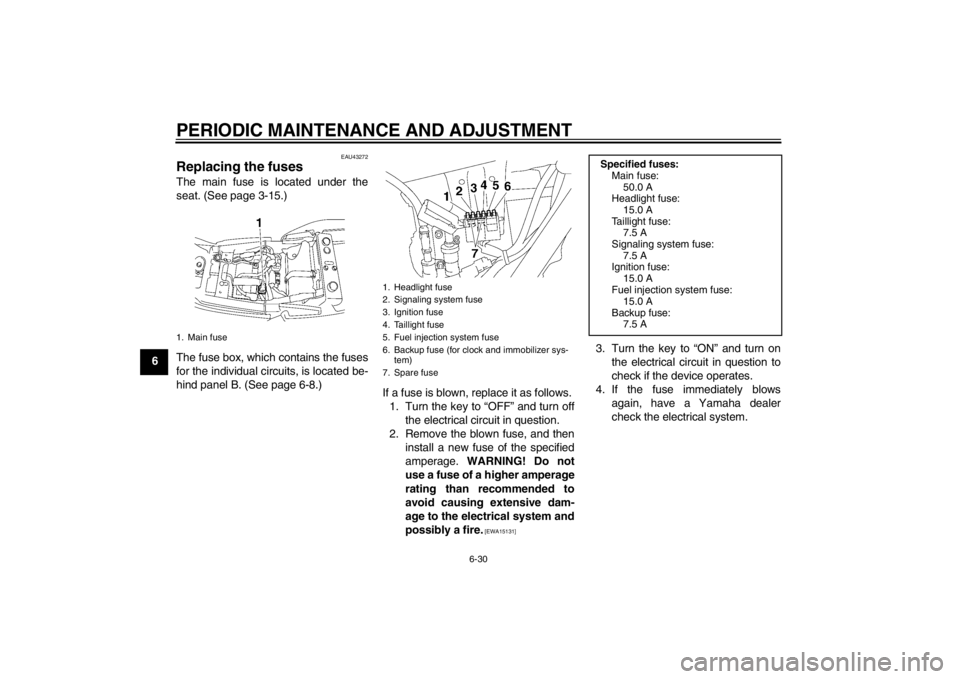seat adjustment YAMAHA XJR 1300 2013 Owners Manual
[x] Cancel search | Manufacturer: YAMAHA, Model Year: 2013, Model line: XJR 1300, Model: YAMAHA XJR 1300 2013Pages: 98, PDF Size: 2.34 MB
Page 6 of 98

TABLE OF CONTENTSSAFETY INFORMATION ..................1-1
DESCRIPTION ..................................2-1
Left view ..........................................2-1
Right view ........................................2-2
Controls and instruments.................2-3
INSTRUMENT AND CONTROL
FUNCTIONS .......................................3-1
Immobilizer system .........................3-1
Main switch/steering lock ................3-2
Indicator lights and warning lights ............................................3-4
Speedometer ..................................3-5
Tachometer ....................................3-5
Multi-function display ......................3-6
Anti-theft alarm (optional) ...............3-9
Handlebar switches ........................3-9
Clutch lever ...................................3-10
Shift pedal .....................................3-11
Brake lever ...................................3-11
Brake pedal ..................................3-12
Fuel tank cap ................................3-12
Fuel ...............................................3-13
Fuel tank breather hose and overflow hose ............................3-14
Catalytic converters ......................3-15
Seat ..............................................3-15
Helmet holder ...............................3-16
Storage compartment ...................3-16
Adjusting the front fork ..................3-17 Adjusting the shock absorber
assembly ................................... 3-19
Luggage strap holders ................. 3-21
EXUP system ............................... 3-22
Sidestand ..................................... 3-22
Ignition circuit cut-off system ........ 3-23
FOR YOUR SAFETY –
PRE-OPERATION CHECKS ............. 4-1
OPERATION AND IMPORTANT
RIDING POINTS ................................. 5-1
Starting the engine ......................... 5-1
Shifting ........................................... 5-2
Tips for reducing fuel consumption ............................... 5-3
Engine break-in .............................. 5-3
Parking ........................................... 5-4
PERIODIC MAINTENANCE AND
ADJUSTMENT ................................... 6-1
Owner’s tool kit ............................... 6-2
Periodic maintenance chart for the emission control system ............. 6-3
General maintenance and lubrication chart .......................... 6-4
Removing and installing panels ..... 6-8
Checking the spark plugs ............... 6-9
Engine oil and oil filter element .... 6-10
Replacing the air filter element and cleaning the check hose .... 6-13 Checking the throttle grip free
play ........................................... 6-14
Valve clearance ........................... 6-15
Tires ............................................. 6-15
Cast wheels ................................. 6-18
Clutch lever .................................. 6-18
Checking the brake lever free play ........................................... 6-18
Brake light switches ..................... 6-19
Checking the front and rear brake pads .......................................... 6-20
Checking the brake and clutch fluid levels ................................. 6-20
Changing the brake and clutch
fluids ......................................... 6-22
Drive chain slack .......................... 6-22
Cleaning and lubricating the drive chain ......................................... 6-23
Checking and lubricating the cables ....................................... 6-24
Checking and lubricating the throttle grip and cable ............... 6-24
Checking and lubricating the
brake and shift pedals .............. 6-25
Checking and lubricating the brake and clutch levers ............ 6-25
Checking and lubricating the centerstand and sidestand ....... 6-26
Lubricating the swingarm
pivots ........................................ 6-27
Checking the front fork ................. 6-27U5WME9E0.book Page 1 Friday, December 7, 2012 3:50 PM
Page 48 of 98

PERIODIC MAINTENANCE AND ADJUSTMENT
6-2
6
EAU17381
Owner’s tool kit The owner’s tool kit is located under the
seat. (See page 3-15.)
The service information included in this
manual and the tools provided in the
owner’s tool kit are intended to assist
you in the performance of preventive
maintenance and minor repairs. How-
ever, additional tools such as a torque
wrench may be necessary to perform
certain maintenance work correctly.TIPIf you do not have the tools or experi-
ence required for a particular job, have
a Yamaha dealer perform it for you.1. Owner’s tool kitU5WME9E0.book Page 2 Friday, December 7, 2012 3:50 PM
Page 54 of 98

PERIODIC MAINTENANCE AND ADJUSTMENT
6-8
6
EAU18771
Removing and installing pan-
els The panels shown need to be removed
to perform some of the maintenance
jobs described in this chapter. Refer to
this section each time a panel needs to
be removed and installed.
EAU43261
Panels A and B
To remove a panel1. Remove the seat. (See page3-15.)
2. Remove the bolt, and then pull the panel off as shown. To install a panel
1. Place the panel in its original posi-
tion, and then install the bolt.
2. Install the seat.
1. Panel A
1. Panel B
2. Panel C
1
2
1. Bolt
1
U5WME9E0.book Page 8 Friday, December 7, 2012 3:50 PM
Page 58 of 98

PERIODIC MAINTENANCE AND ADJUSTMENT
6-12
69. Install new O-rings onto the ele-
ment cover bolt and element cov-
er.
10. Apply a thin coat of clean engine oil to the O-rings.
11. Insert the element cover bolt into the element cover.
12. Fit the spring, washer and a new oil filter element over the bolt.
TIPMake sure the O-rings are properly
seated.
13. Install the engine oil filter elementcover (together with the spring,
washer and oil filter element) by
aligning the projection on the cover
with the slot in the crankcase, and
then tightening the bolt to the
specified torque.
14. Install the oil filter element drain screw and its new gasket, and
then tighten the screw to the spec-
ified torque. 15. Install the panel.
16. Install the engine oil drain bolt and
its new gasket, and then tighten
the bolt to the specified torque.
17. Refill with the specified amount of the recommended engine oil, and
then install and tighten the oil filler
cap.
1. O-ring
2. Oil filter element cover bolt
3. Oil filter element cover
4. Compression spring
5. Washer
6. Oil filter element
2
3
4
5
6
1
1. Projection
2. SlotTightening torque: Oil filter element cover bolt:15 Nm (1.5 m·kgf, 11 ft·lbf)
Tightening torque:Oil filter element drain screw:
7 Nm (0.7 m·kgf, 5.1 ft·lbf)
Tightening torque: Engine oil drain bolt:43 Nm (4.3 m·kgf, 31 ft·lbf)
Recommended engine oil: See page 8-1.
Oil quantity: Without oil filter element replace-
ment:
2.80 L (2.96 US qt, 2.46 Imp.qt)
With oil filter element replacement: 3.15 L (3.33 US qt, 2.77 Imp.qt)
U5WME9E0.book Page 12 Friday, December 7, 2012 3:50 PM
Page 60 of 98

PERIODIC MAINTENANCE AND ADJUSTMENT
6-14
63. Pull the air filter element out.
4. Insert a new air filter element into
the air filter case. NOTICE: Make
sure that the air filter element is
properly seated in the air filter
case. The engine should never
be operated without the air filter
element installed, otherwise the
piston(s) and/or cylinder(s) may
become excessively worn.
[ECA10481]
5. Install the air filter case cover by in- stalling the screws.
6. Install the panel. To clean the air filter check hose
1. Check the hose on the front of the air filter case for accumulated dirt
or water.
2. If dirt or water is visible, remove the hose, clean it, and then install
it.
EAU21384
Checking the throttle grip free
play The throttle grip free play should mea-
sure 3.0–5.0 mm (0.12–0.20 in) at the
inner edge of the throttle grip. Periodi-
cally check the throttle grip free play
and, if necessary, have a Yamaha deal-
er adjust it.
1. Air filter element
1. Air filter check hose
1. Throttle grip free play
U5WME9E0.book Page 14 Friday, December 7, 2012 3:50 PM
Page 74 of 98

PERIODIC MAINTENANCE AND ADJUSTMENT
6-28
6
EAU45511
Checking the steering Worn or loose steering bearings may
cause danger. Therefore, the operation
of the steering must be checked as fol-
lows at the intervals specified in the pe-
riodic maintenance and lubrication
chart.1. Place the vehicle on the center- stand. WARNING! To avoid inju-
ry, securely support the vehicle
so there is no danger of it falling
over.
[EWA10751]
2. Hold the lower ends of the front fork legs and try to move them for-
ward and backward. If any free
play can be felt, have a Yamaha
dealer check or repair the steering.
EAU23291
Checking the wheel bearings The front and rear wheel bearings must
be checked at the intervals specified in
the periodic maintenance and lubrica-
tion chart. If there is play in the wheel
hub or if the wheel does not turn
smoothly, have a Yamaha dealer check
the wheel bearings.
EAU50290
Battery The battery is located under the seat.
(See page 3-15.)
This model is equipped with a VRLA
(Valve Regulated Lead Acid) battery.
There is no need to check the electro-
lyte or to add distilled water. However,
the battery lead connections need to be
checked and, if necessary, tightened.
WARNING
EWA10760
●
Electrolyte is poisonous and
dangerous since it contains sul-
furic acid, which causes severe
burns. Avoid any contact with
1. Negative battery lead (black)
2. Battery
3. Positive battery lead (red)
1
3
2
U5WME9E0.book Page 28 Friday, December 7, 2012 3:50 PM
Page 76 of 98

PERIODIC MAINTENANCE AND ADJUSTMENT
6-30
6
EAU43272
Replacing the fuses The main fuse is located under the
seat. (See page 3-15.)
The fuse box, which contains the fuses
for the individual circuits, is located be-
hind panel B. (See page 6-8.)If a fuse is blown, replace it as follows.
1. Turn the key to “OFF” and turn off the electrical circuit in question.
2. Remove the blown fuse, and then install a new fuse of the specified
amperage. WARNING! Do not
use a fuse of a higher amperage
rating than recommended to
avoid causing extensive dam-
age to the electrical system and
possibly a fire.
[EWA15131]
3. Turn the key to “ON” and turn on the electrical circuit in question to
check if the device operates.
4. If the fuse immediately blows again, have a Yamaha dealer
check the electrical system.
1. Main fuse
1. Headlight fuse
2. Signaling system fuse
3. Ignition fuse
4. Taillight fuse
5. Fuel injection system fuse
6. Backup fuse (for clock and immobilizer sys-tem)
7. Spare fuse
Specified fuses: Main fuse:
50.0 A
Headlight fuse:
15.0 A
Taillight fuse: 7.5 A
Signaling system fuse: 7.5 A
Ignition fuse:
15.0 A
Fuel injection system fuse: 15.0 A
Backup fuse: 7.5 A
U5WME9E0.book Page 30 Friday, December 7, 2012 3:50 PM